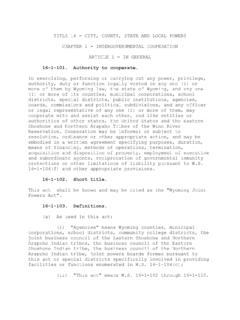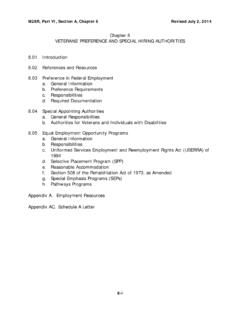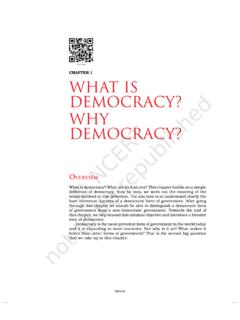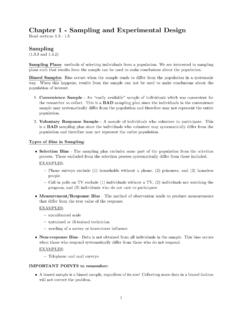Transcription of Chapter 8: Related Parties - University of Illinois Urbana ...
1 2009 Chapter 8: Related Parties2798 Chapter 8: Related PartiesThere are many provisions in the Internal Revenue Code that concern Related Parties . Many of these provisionshave their own definitions of who is considered a Related party. Two of the most far-reaching definitions arefound in IRC 267 and 318. Although many Related -party passages refer to these two code sections, they makemodifications to the parameters of the definition. For example, a provision may substitute an 80% or moreownership test for the more than 50% ownership test found in a particular Code section. Consequently, it isimportant to check the specific Related -party definition for each relevant we hear the term Related Parties , we typically think of the taxpayer and family members, including the spouse,parents, grandparents, children, and grandchildren.
2 However, Related Parties may also include brothers and sisters andtheir children, and, in many cases, entities in which the taxpayer owns a majority , Related Parties include entities in which the taxpayer does not directly own a majority interest, but has amajority interest when indirect ownership is taken into account. The indirect-ownership test is one that Congressadded in order to eliminate a loophole. The loophole involved taxpayers who did not own a majority interest in anentity directly but instead had the direct ownership divided among family members so that the Related -party ruleswould not apply. Congress plugged this loophole by including indirect ownership in the ownership calculations. Indirect ownership generally means the taxpayer is considered to own any interest held by other Related indirect ownership is taken into account at only one level.
3 Consequently, an indirect ownership determined tobelong to one person does not in turn belong to another person Related to the first indirect IS Related ?Introduction .. 279 Who Is Related ?.. 279 Timing of Deductions forPayments Between Related 282 Sales Between Related 282 Reasonable Rental Expenses .. 284 Transfers Between Spousesor 285 Sales or Exchanges ofDepreciable Property .. 286 Installment 287 Below-Market Loans .. 291 Cancellation of Debt .. 294 Like-Kind Exchanges .. 294 Involuntary Conversions .. 304 Controlled Group of Corporations .. 305 Redemption of Stock in a Family 311 Wash Sales .. 312 Bonus Depreciation .. 312 IRC 179 (Expensing) .. 313 Retirement Plans .. 313 Partnership Income and Losses .. 314 Trusts .. 315 Estate Tax Provisions .. 316 Per Diems .. 317 Summary of IRC 267 Related Parties .
4 3182009 WorkbookCopyrighted by the Board of Trustees of the University of Illinois . This information was correct when originally published. It has not been updated for any subsequent law changes. Corrections were made to this workbook through January of 20. No subsequent modifications were Chapter 8: Related PartiesExample 1. Walter directly owns 40% of stock in ABC Corporation. Walter s daughter Melodie owns noneof the stock directly but indirectly owns this same stock and therefore has a 40% ownership in ABCC orporation. Melodie s husband, Eric, does not own any of the stock directly. None of Walter s ownership isattributed to him since the relationship between Eric and Walter (in-laws) is generally not one of the relatedparties for attribution and because the indirect ownership was already attributed to 267 RELATIONSHIPSIRC 267(b) has 13 different relationships that make up Related Parties .
5 These of a family, including: Husband and wife; Brothers and sisters including half-siblings; Ancestors parents, grandparents, etc.; and Lineal descendants children (including adopted children),1 grandchildren, etc.; individual and a corporation in which the individual owns, directly or indirectly, more than 50% of thevalue of the outstanding stock; corporations which are members of the same controlled group; grantor and a fiduciary of any trust; fiduciary of a trust and a fiduciary of another trust, if the same person is a grantor of both trusts; fiduciary of a trust and a beneficiary of the trust; fiduciary of a trust and a beneficiary of another trust, if the same person is a grantor of both trusts; fiduciary of a trust and a corporation in which more than 50% of the value of the outstanding stock isowned, directly or indirectly, by or for the trust or a person who is a grantor of the trust.
6 Person and an organization to which IRC 501 applies and which is controlled directly or indirectly bysuch person or by members of the family of such individual; corporation and a partnership if the same persons own more than 50% of the value of the outstandingstock of the corporation and more than 50% of the capital or profits interest in the partnership; S corporation and another S corporation, if the same persons own more than 50% of the value of theoutstanding stock of each corporation; S corporation and a C corporation, if the same persons own more than 50% of the value of theoutstanding stock of each corporation; executor of an estate and a beneficiary of such estate, except in the case of a sale or exchange insatisfaction of a pecuniary sale between a taxpayer and a stepparent is not a sale between Related Parties because the stepparent is notconsidered a part of the taxpayer s Tax Court ruled that a sale between a taxpayer and his wife s grandson through another marriage was not a sale toa Related party.
7 IRC 267 does not include a stepgrandchild as part of the taxpayer s Reg (c)-1(a)(4). Rul. 71-50, 1971-1 CB v. Comm r, TC 662 (1951).2009 WorkbookCopyrighted by the Board of Trustees of the University of Illinois . This information was correct when originally published. It has not been updated for any subsequent law changes. 2009 Chapter 8: Related Parties2818 IRC 318 RELATIONSHIPSIRC 318 concerns constructive ownership of stock. The relationships that make up the Related Parties under 318 include: Members of a family. This includes husband and wife, ancestors, and lineal descendants. The definitionunder 318 does not include brothers and sisters. The constructive ownership rules do not provide forattribution beyond the taxpayer s parents. This means the parents stock is attributed to the taxpayer, but thegrandparents stock is not attributed.
8 Attribution from partnerships and estates. Stock owned, directly or indirectly, by or for a partnership orestate is considered owned proportionately by its partners or beneficiaries. Attribution from trusts. Stock owned, directly or indirectly, by or for a trust is considered as owned by its beneficiaries inproportion to the beneficiaries interests in the trust. This rule does not apply to IRC 401(a)employees trusts. Stock owned, directly or indirectly, by or for any portion of a trust of which a grantor of a trust istreated as a substantial owner is considered as owned by the grantor. Attribution from corporations. If 50% or more of the value of a corporation s stock is owned, directly orindirectly, by or for a person, that person is considered to own any stock that the corporation owns, directlyor indirectly, in proportion to the person s ownership interest in the corporation s stock.
9 Attribution to partnerships and estates. Stock owned, directly or indirectly, by or for a partner or abeneficiary of an estate is considered as owned by the partnership or estate. Attribution to trusts. Stock owned, directly or indirectly, by or for a beneficiary of a trust is considered as owned by thetrust, unless the beneficiary s interest is a remote contingent interest (5% or less of the value of thetrust property). Stock owned, directly or indirectly, by or for a person who is considered the owner of any portion ofa trust is considered as owned by the person. Attribution to corporations. If 50% or more of the value of a corporation s stock is owned, directly orindirectly, by or for any person, the corporation is considered to own the stock owned by or for such INSIDE PASS-THROUGH ENTITYFor purposes of both 267 and 318, any ownership inside a pass-through entity, such as a partnership, is deemed tobe owned directly by the entity s owners on a proportionate basis.
10 For example, a 20% owner of a partnership owns20% of any entity the partnership WorkbookCopyrighted by the Board of Trustees of the University of Illinois . This information was correct when originally published. It has not been updated for any subsequent law changes. 2822009 Chapter 8: Related PartiesAccrual-basis taxpayers generally can claim a deduction for vacation pay, salaries, and other expenses accrued as ofthe last day of the tax year if these items are paid within the first 2 months after the end of the year. For example, anaccrual of these expenses on December 31, 2009, can be deducted if they are actually paid by March 15, 267(a)(2) sets specific rules for these accrued expenses when Related Parties (within the meaning of 267(b)described above) are involved. In brief, it states that an accrual-basis taxpayer cannot take the deduction until the datethe cash-basis Related party is required to include the amount in 2.










